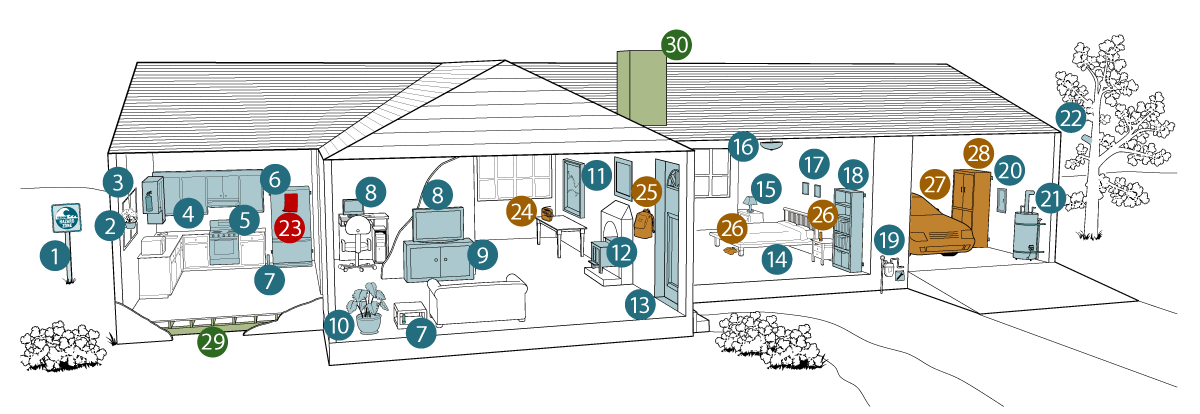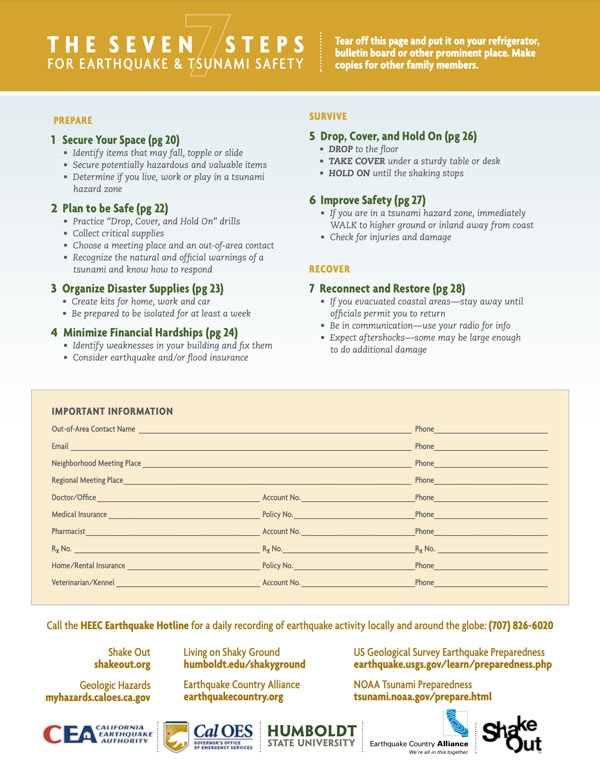Seven Steps That May Save Your Life
Earthquakes and tsunamis are inevitable but the damage is not—even in a great earthquake on the Cascadia subduction zone. Most damage and loss can be reduced by steps you take before, during, and after.
The seven steps that follow include actions to keep you and your loved ones safe, reduce potential damage and recover quickly.
These steps should also be followed in schools, workplaces, and other facilities. By following them, countless casualties can be avoided and millions of dollars saved.
Preparation is the key to surviving a disaster—that much is clear—but where should you start? Start by talking—talk to your family, friends, neighbors and co-workers about what you’ve learned in this handbook about earthquakes and tsunamis in Northern California. Then discuss what you have done to prepare and together plan your next steps.
Many people are overwhelmed by the mere prospect of a natural disaster and, as a result, don’t prepare at all. Do not fall into that trap. You can start today by following these seven steps.
Visit earthquakecountry.org for instructions and resources.
PREPARE
Step 1: Identifying Hazards & How to Fix Them
- Identify items that may fall, topple or slide
- Secure potentially hazardous and valuable items
- Determine if you live, work or play in a tsunami hazard zone
Step 2: Create a Disaster Preparedness Plan
- Collect critical supplies
- Sign up for emergency alerts
- Special considerations: Children, elderly, pets, and livestock.
Step 3: Organize Disaster Supplies
- Create kits for home, work, and car
- Be prepared to be isolated for at least a week
Step 4: Minimize Financial Hardships
- Identify weaknesses in your building and fix them
- Consider earthquake and/or flood insurance
SURVIVE
Step 5: Drop, Cover, and Hold On
- DROP to the floor
- TAKE COVER under a sturdy table or desk
- HOLD ON until the shaking stops
Step 6: Improve Safety
- If you are in a tsunami hazard zone, immediately WALK to higher ground or inland away from coast
- Check for injuries and damage
RECOVER
Step 7: Reconnect and Restore
- If you evacuated coastal areas—stay away until officials permit you to return
- Be in communication—use your radio for info
- Expect aftershocks—some may be large enough to do additional damage
30 Suggestions to Make Your Home Earthquake Safe
Connect these actions with their locations in the house below.

Step 1—Identify hazards
- Know whether you live, work or playin a tsunami hazard zone.
- Hang plants in light weight pots with closed hooks, well secured to a joist or stud and far away from windows.
- Store fire extinguisher (type ABC) in easily accessible location.
- Install strong latches on kitchen cabinets.
- Use flexible connections where gas lines meet appliances.
- Remove or lock refrigerator wheels, secure to studs.
- Keep several flashlights in easily accessible places around the house.
- Secure valuable electronics items such as computers and televisions.
- Keep breakables in low or secure cabinets with latches.
- Move heavy plants and other large items to floor or low shelves.
Step 1—Identify hazards (cont.)
- Hang mirrors and pictures on closed hooks.
- Secure free-standing wood stove or fireplace insert.
- Keep heavy unstable objects away from doors and exit routes.
- Place bed away from windows or items that mayfall.
- Secure knick knacks and other small valuables with museum putty.
- Brace overhead light fixtures.
- Place onlylight weight/soft items over bed.
- Secure top-heavy furniture to studs.
- Keep wrench or turn-off tool in water proof wrap near gas meter.
- Know the location ofyour main electrical switch (fuse box or circuit breaker).
- Secure water heater with metal straps attached to studs.
- Trim hazardous tree limbs.
Step 2—create a plan
- Have your emergency plan accessible and discuss with all family members.
Step 3—prepare disaster kits
- Obtain a NOAA Weather Radio with the Public Alert feature to notify you of tsunamis and other hazards.
- Keep an emergency backpack with copies of important documents near the door to grab and go.
- Keep flashlight, slippers and gloves next to beds.
- Keep gas tank at least half full.
- Store emergency food and water supplies in a dry accessible area. Include first aid kit, extra cash, portable radio, extra batteries, medications and other necessary supplies.
Step 4—strengthen your home
- Use anchor bolts every 4 to 6 feet to secure home to foundation.
- Reinforce brick chimneys.
